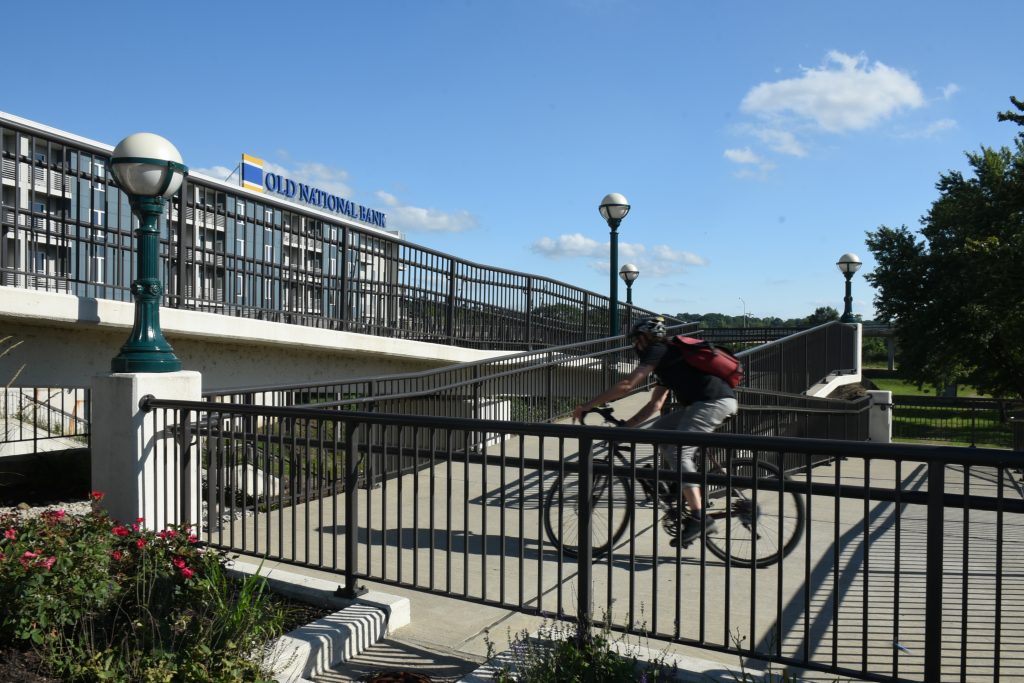BY RADONNA FIORINI
PHOTOS BY CHRISTINE PETKOV
Located west of the Marq Apartments and Old National Bank along the Wabash River, the Riverside Promenade Deck was dedicated in July 2020 and represents the first completed project in the
“Two Cities, One River” master plan designed to enhance the quality of life along the Wabash, says Stan Lambert, executive director of the Wabash River Enhancement Corporation.
The promenade is a city block long, rising above railroad tracks and the river bank. It connects on the north to the John T. Myers Pedestrian Bridge next to Reihle Plaza, and to Columbia Street on the south, says Eric Lucas, principal with MKSK, the landscape architecture and urban design company that oversaw the project. Access also is available from the Marq building.
Because railroad tracks prevent access or a good view of the river from ground level, the promenade is at bridge level and pedestrians can enjoy a good view of the waterway without obstruction. The deck zig zags a bit, meandering through the space to mimic the flow of the river.
“The whole space takes its shape from the river,” Lucas says. “Seats rise up and tilt in different angles so the space mimics the river both horizontally and vertically. It is 15 feet wide at the narrowest spot, and 30 feet or so at its widest.” The configuration includes spaces large enough to accommodate a band or other type of entertainment.
The deck is constructed of sustainable, durable hardwood slats and steel beams with stainless steel cable netting around the perimeter. Planting areas and free-standing containers have been seeded with native pollinator flowers and grasses.
Decorative pole lights line the walkway and glowing lights under the benches brighten the pathway from dusk into the night. Even the area directly under the deck has been incorporated into the overall plan, says Lucas. A few metal grates were installed so walkers can look 20-feet down and see vegetation below. Native trees and ornamental shrubs have been planted there, some of which will eventually grow up through the grates, turning the deck into a more natural landscape.
Another feature people enjoy is an Americans With Disabilities Act-accessible walkway that connects the promenade deck to Reihle Plaza and Main Street. The gently sloping walk is a favorite with bikers and those with limited mobility, allowing stairless access from the street to the deck and the pedestrian bridge leading into West Lafayette, Lucas says.
Dennis Carson, Lafayette economic development director, says, “It’s a great event space – wide and with excellent views of the river. Even though COVID has shut a lot of things down, I see people walking on the deck and having their lunch there. We’ll be able to use it more fully in the future.”
Carson calls the Wabash a “great asset” and sees lots of opportunities for public use, recreation and private development along the river. The enhancement effort along the Wabash has been underway for more than a decade, as it began in earnest in 2004 when the WREC was formed.
The last 17 years have been spent creating and refining the master plan for public and private development along the river in Tippecanoe, Fountain, Warren and Carroll counties; creating partnerships between government officials, Purdue University, and private entities; acquiring land along the river bank; and working on watershed issues, says WREC’s Lambert.

The plan envisions a time when the river becomes the “…healthy, beautiful centerpiece of a whole, interconnected community. Building on the river’s beauty, the plan seeks to restore a healthy river ecosystem and create recreation and related amenities to create a unique quality of life and make the region a place of choice—especially for attracting and retaining employees in the high technology and bio-life sciences sectors.”
With a solid road map in place, the non-profit WREC is ready to move forward with some of the proposed projects, particularly in the Lafayette/West Lafayette urban corridor, but funding is always an issue.
The promenade deck project was pushed to the front of the line in 2015 when private developers started work on the mixed-use development that now houses the Marq apartments and Old National Bank regional headquarters.
“The promenade was in the masterplan, so we had to do it concurrently (with the Old National development) if it was going to happen,” Lambert says. “We had to get the whole project completed, including fundraising, in a very short time.”
With a $2.2 million grant from North Central Health Services, $600,000 from the city of Lafayette, and $485,000 from WREC, work on the promenade began in 2016 with plans to wrap up in about a year. Several construction setbacks and COVID-19 slowdowns pushed the finish date to 2020, but the $3.2 million project is now complete.
No other brick and mortar projects are currently underway along the riverfront, but the WREC is refining plans for the river corridor and pursuing grants and private donations for remediation of some industrial sites and development of greenspaces. The WREC has purchased 28 properties along the Wabash in Tippecanoe County and will work on river bank restoration and stormwater management.
A $325,000 grant from the Indiana Department of Environmental Management and the United States Environmental Protection Agency awarded in March will help the corporation address water quality issues in this area of the Wabash River watershed, according to information from WREC Watershed Coordinator Shannon Stanis, who will oversee the grant.
Most of that money will go toward a cost-sharing program that encourages those living within the watershed to adopt pollution reducing and water quality enhancing practices. The grant also will fund educational and community outreach programs as well as water quality testing. A similar grant obtained in 2019 was used for such projects as rain barrel and rain garden installations, tree and native turf planting, and streambank stabilization. These efforts helped reduce the amount of nitrogen, phosphorous and sediment flowing into the Wabash.
While there may not be any flashy projects in the works, there is more interest and investment than ever in downtown Lafayette and the State Street corridor in West Lafayette, Lambert says. He cites tremendous returns from money invested in riverfront enhancement in other Indiana communities.
“These kinds of projects are costly and take a long time to do, but cities who invest in their riverfronts see a $5 return for every dollar invested within five years, and a $12 to $16 return for every dollar invested in 20 years,” Lambert says. The biggest problem is finding a dedicated funding source that is not subject to the vagaries of politics and changes in governmental policies.
He harkens back to the years-long railroad relocation effort in Lafayette that removed tracks from downtown streets. About 80 percent of the funding for that multi-million dollar project came from the federal government through earmarks in the federal budget. But that funding source was eliminated years ago, Lambert recalls.
“WREC is putting together a dedicated funding plan, looking at a food and beverage tax fund or something like that to help support and develop the riverfront,” he says. “That would spread the cost across the most people, and primarily those who are using the services.”
Any tax would have to be authorized by the state and Tippecanoe County Council, and no concerted effort to pursue such a fund is currently in the works.
If the stars align and consistent funding becomes available, Lambert sees a future for life along the Wabash River in Tippecanoe County that will include private mixed-use development, a new pedestrian bridge extending Brown Street across the river into West Lafayette, new parks and green space, small boat docks, a disc golf course, a band shell for outdoor entertainment, mountain bike trails and more.
In the meantime, why not plan a leisurely stroll along a promenade? ★
More information about the Wabash River master plan, including maps and historical perspectives, is available at wabashriver.net
Interested in partnering with the WREC on a pollution-reducing cost-share project? Visit: wabashriver.net/costshare





